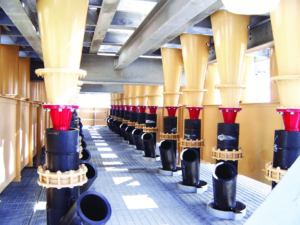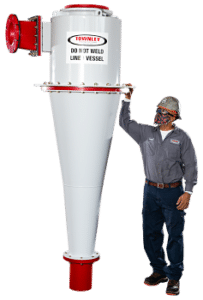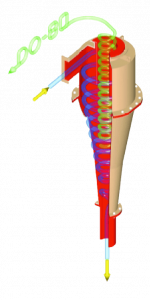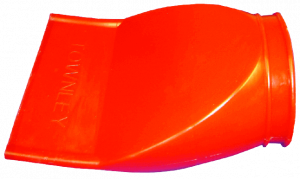How to Fix Common Issues with Hydrocyclones
Greg Bundy
Product Manager
Troubleshooting Performance
Hydrocyclones are quite possibly the simplest piece of mineral processing equipment, as they have no moving parts, and just rely on the geometry of the equipment and the incoming pressure they are fed to perform the separation. They often operate for years, providing consistent size separation or dewatering performance, requiring limited maintenance or operational input.
However, as a result, when they ultimately do require modification to adjust the performance, there is often a limited level of expertise in hydrocyclone performance on most operational sites. Therefore, this guide is designed to provide a beginning level of troubleshooting information for when your cyclone is not performing to design.
When troubleshooting, the first step is to identify why you want to adjust the hydrocyclone performance. It will generally be for one of two reasons.

The first reason could be the separation of water is incorrect, typically noted when too much water is spraying out the underflow (known as the apex or spigot) of the cyclone, or when nothing is going out the overflow (through the vortex finder). The second reason could be when the separation of solids is incorrect. This is caused when the hydrocyclone is cutting at the wrong particle size (known as the d50 or p80 cut size of the hydrocyclone), or you want to make a coarser or finer cut.
The second step in identifying the problem is to identify if this unwanted performance is constant, or if it is intermittent (meaning the hydrocyclone works properly for a while and then has problems again).
In this article, we will start by troubleshooting a standard classifying hydrocyclone. We will first look at problems associated with poor water separation, and then look at how to adjust the solids separation. We will then finish by looking at how troubleshooting dewatering or siphon-assisted hydrocyclones may differ from the standard classifying hydrocyclones.
Getting the Proper Water Separation
The vast majority of hydrocyclone performance issues are pressure-related. I would guess that 90% or more of all the issues I have been involved in troubleshooting over the last twenty-plus years in the industry have been due to improper inlet pressure.
Therefore, the starting point to troubleshooting performance is always going to be to verify the inlet pressure. This can only be done with a working pressure gauge or transmitter located at the inlet to the hydrocyclone.
For a hydrocyclone to work properly, and make a good separation the majority of the water must go through the overflow. This requires at least 5-6 psi pressure to the inlet of the cyclone. Anything less than that, and you will not have enough force within the hydrocyclone to maintain the cyclonic action required for separation.
If you find the feed pressure is constantly too low, here are some of the things to look for to fix the problem:
- Insufficient feed flow (pump speed too low, pump cavitation)
- Blockage in the feed line
- If multiple hydrocyclones are being fed by one pump, close the feed to one hydrocyclone at a time to increase inlet pressure to the others
If you find the pressure fluctuates from normal to too low, here are some things to look for to fix the problem:
- Pump cavitation
- Pump drive belt slippage
- Feed sump level dropping too low (causing pump cavitation)
- Blockage in the feed line
- Pump speed fluctuating – Should be fed constant pressure, and should not generally be fed with a variable speed pump that fluctuates during operation
- Feed sump designed incorrectly resulting in inconsistent feed being pumped
If inlet pressure is adequate, and you are still seeing too much water spraying out the underflow, here are a few other items to check:
- Too low of solids in the feed. This can be caused by feeding a diluted slurry or a reduction of solids in the system. To fix this, increase the density of solids feeding the hydrocyclone, or decrease the size of the apex.
- The apex will be the fastest wearing part of most units. When the apex wears out, the opening gets larger, therefore allowing more water to go out the underflow. To fix this, replace the apex with a new one. Apexes should typically be replaced when the inside diameter wears to about 7% greater than the original size.
- A blockage within the cyclone. This could be caused by a worn liner pulling loose, impeding the flow somewhere, or something blocking the apex or overflow pipe.
Getting Proper Solids Cut Size Separation
The other issue typically facing hydrocyclone operation is getting the desired particle cut size. This can manifest itself by seeing too many fines or clays in the underflow, or by some coarser particles reporting to the overflow.

The first thing to look at if you are not getting the correct solids separation is the bottom discharge at the apex. It should be a slight outward fanning spray as the material exits the apex. If the underflow discharge is very thick and comes straight down out of the hydrocyclone, it is called “roping”.
If you see this, it means that the apex is too small for the number of solids wanting to discharge out the underflow. This will push the material out of the overflow instead of the underflow. If this is happening, you can guarantee your cyclone is not separating properly. To fix this, you can typically do one of three things:
- Utilize an apex with a larger opening
- Reduce the percent solids being fed
- If you have multiple cyclones in a system, turn on another to handle the additional solids flow
If the underflow discharge looks good with a slight fanning spray as the material comes out of the apex you will need to adjust the cut size. You can make it coarser (more material out the overflow) or finer (more material out the underflow).
To make a hydrocyclone cut finer, here are some of the options generally available:
- Increase feed pressure/flow. The higher the feed pressure to the hydrocyclone, the finer the cut it will make, and the more solids will report to the underflow. Please note that you must always ensure to keep the pressure below the manufacturer’s stated maximum safe pressure to prevent failure or safety concerns.
- If there are multiple hydrocyclones in a system, reduce the number of operating hydrocyclones to increase the pressure and flow to the remaining operating hydrocyclones.
- Utilize a smaller vortex finder
- Utilize a longer cone body with a smaller cone angle
- Add a cylinder section between the feed chamber and the upper cone section
- Replace with a larger quantity of smaller diameter hydrocyclones
- Reduce the density of the feed (especially at high densities)
To make a hydrocyclone cut coarser, you can do the following:
- Reduce feed pressure/flow (but maintain above 5-6 psi)
- If there are multiple hydrocyclones in a system, increase the number of operating hydrocyclones to reduce the feed pressure to each operating hydrocyclone (while maintaining at least 5-6 psi feed pressure)
- Utilize a larger vortex finder
- Utilize a shorter cone body with a larger cone angle
- Replace hydrocyclones with a smaller quantity of larger diameter hydrocyclones
- Laying a hydrocyclone on its side, to a 45-degree angle or even down to a 15-degree angle from horizontal can significantly increase the cut size
- Increase the density of the feed (especially at high densities)
Troubleshooting Dewatering Hydrocyclones
Dewatering or siphon-assisted hydrocyclones are a modification of a standard classifying hydrocyclone. They consist of a standard hydrocyclone, where a rubber or urethane underflow regulator, an extended overflow pipe (typically going about 6 feet below the bottom of the hydrocyclone), and a siphon control panel are added to increase the underflow density produced by the hydrocyclone.

While a majority of the above conversation is applicable for dewatering hydrocyclones, especially when looking at the solid cut size, there are a few additional items to look at when troubleshooting dewatering hydrocyclones. If you are not getting the expected level of water removal from the dewatering hydrocyclone underflow, here is a list of the top items to look for to improve the underflow density.
- Verify feed pressure. If you have gotten this far in the article, you know this is the starting point for troubleshooting any hydrocyclone problem. For dewatering hydrocyclones, you have the same minimum pressure limit of 5-6 psi, which if not met will result in water spraying out the underflow. (However, for dewatering hydrocyclones, there is also a firm maximum feed pressure limit of about 14-15 psi. If the pressure goes above this limit, the internal pressure will overcome the siphon pressure, and water will spray out the underflow. As a result, both low and high feed pressure looks pretty much the same visually, and typically cannot be differentiated without an accurate pressure reading)
- Dewatering hydrocyclones rely on a siphoning effect caused by the underflow regulator and the extended feed pipe. If this siphon is lost, the dewatering effect will be lost. Several things can cause this loss of siphon:
- Underflow regulator has a rip, crack, or doesn’t close properly
- Hole in the overflow pipe, siphon control valve line, or top of hydrocyclone allowing air into the system
- Water not filling up overflow pipe. Can be caused by too high of feed density (should be limited to 25% solids by weight for silica sand) or the need to add a reducing overflow boot to the end of the overflow pipe to reduce the effective diameter.
- Siphon Control Panel – this valve controls the amount of air allowed into it. If the valve is opened further, it allows more air in, partially breaking the siphon, and resulting in a wetter underflow. Closing the valve further will result in a stronger siphon and a dryer underflow. Typically, for the start-up of a new dewatering hydrocyclone, if you are utilizing a standard ball valve, you start with the valve half-open and adjust based on a visual inspection of the underflow.
Please note the above article is a general discussion of typical hydrocyclone issues and some beginning ideas of how to fix them. For specific application information, please contact Townley Engineering and Manufacturing.
